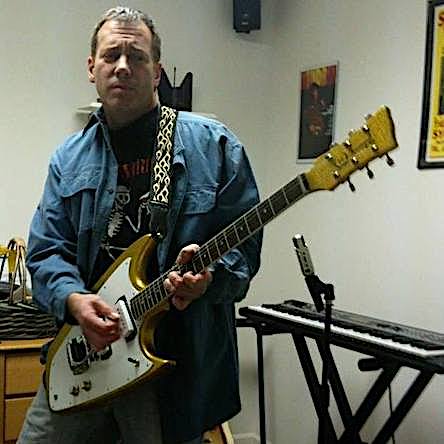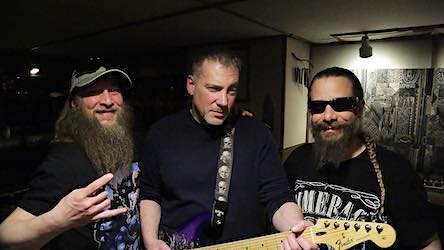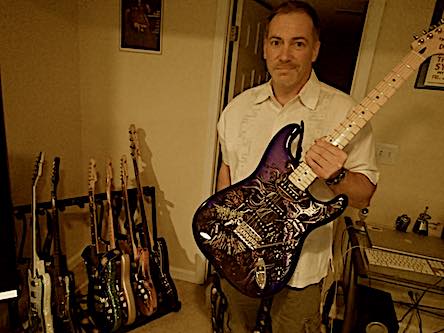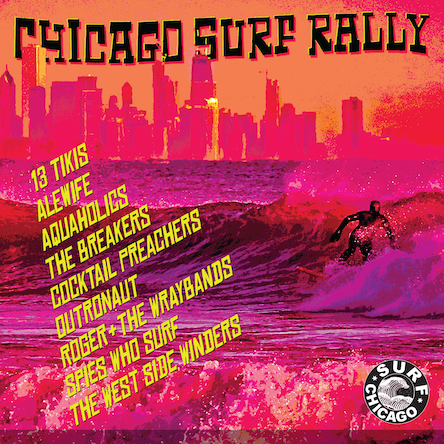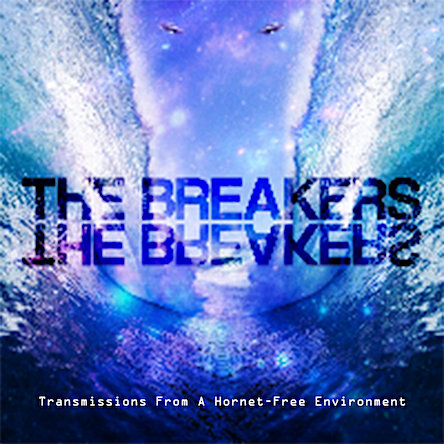 
|
||||
|
|
THE BREAKERS |
|||
|
mwe3.com presents an interview with
Jim Abrahams: Well, a mutual friend who was bartending at a local venue suggested that I come play some guitar at an open mic that they had started there. I didn’t know how many people would want to hear surf instrumental tunes, or know any of them to play along with. So, I programmed a Digitech drum pedal with 6 songs, and figured I’d do like a 1-man Joy Division / Surf set. Before I had the chance, I met Marc, who, as it turned out, was running the open mic, and who said, “I love that stuff! I’ll play with you, and I think I know a bass player here who would fit the bill.” It clicked right away, and I have literally never used that drum pedal, after spending all the time programming that thing! It got to the point where we were pretty much regular staples at that open mic, and that thing became our practice, pretty much. I would email the guys covers to do, and some new ideas, and we would talk about some new original ideas over a beer there, as well. That was the start. mwe3: When did you write and record the 2020 Breakers album Voodoo Treatment, and who plays with you on the album? Also, tell us about working with producer Craig Williams and what he brought to the sound and vision of the new Breakers album? Jim Abrahams: We wrote it in 2019, and pretty much recorded it towards the end of 2019. The band is myself on guitar, Marc Lockett on drums and Jayson Slater on bass. We occasionally get some help from our talented friends – on this one, Chris Stavrou, who plays some stellar cello on the title track, Dan Klapman, who lays down some great sax on a couple of songs, and Matt Casey, who handles percussion in spots. Also, Bruno Kriese, who is like our utility 4th guy in the studio, plugged in on percussion and bass, periodically. Usually, I will develop the basic riffs and song ideas, and the guys will contribute suggestions and their own parts, which are sometimes a lot different, and better, than what I originally had in mind; it is a pretty collaborative process, and the songs have ended up coming along pretty well! Craig is fantastic. He has had a long career in the Chicago area, with his Dr. CAW Recording studio, recording the likes of Styx, Dave Mason, Michael McDermott, Harvey Mandel and others. We come into the studio with our ideas pretty much already developed, and he really helps shape up the rough edges. He both really pushes us to focus and play well, and helps round out and shape some of the final arrangements. Craig is not hesitant to provide pretty direct feedback, like, “That was pretty good – except for the whole guitar part, which sucked. Let’s do it again.” Hahaha. He most definitely contributes heavily to the creative process and final output.
Jim Abrahams: I usually lean towards Fender Stratocasters. I just love the flexible single coil tones, and have more than a few that all have their different unique tonal characteristics. I’ll usually go to one of 4, depending on what I’m reaching for in the song. I have used a few others as well, though, including a new Hallmark Custom 60 that I picked up over the holidays last year, and a couple of Dean Zelinsky Private Label Tagliares, which are like super-Strats, that I have. The backs of the necks on the Tagliares are carved, so less of the surface area of your hand comes in contact with the neck, making it faster and easier to run up and down the neck. It really does work! I had been eying those for a while, and after we played a particularly hot, 90+ degree show at a 4th Of July Party outside a couple of years ago, where my hand was sticking to the neck repeatedly, I decided I had to get one. Both Dean and Bob Shade, of Hallmark, are also super guys, and Wayne Jarrett did a phenomenal job of flame – painting the Hallmark. It looks like it sounds – nuts! I probably used 7 or 8 different guitars on this recording. In terms of amps, I usually record through either the vintage Vox AC 30 that Craig has there, or my Fender Vibroluxe. I think I have used a Bassman a couple of times, as well. In terms of effects, wow. The fundamental thing that is almost always there in one way or another for our stuff is the spring reverb. I use the Surfy Industries Surfy Bear, a spring reverb tank that is driven by mosfet chips instead of tubes. It is fantastic, and to me, indistinguishable from my old Fender spring tank. I also use the Source Audio True Spring, which is a fantastic and flexible Spring Tank emulation pedal, from time to time. I like to use Echorec and Echoplex plate and tape echo effects, sometimes in combination with modulation, to add some atmosphere, and also to create some weird, outer-space, warped sounds with at times. I will use the Xotic effects EP Booster at times in the studio, but much more so live, and usually rely on the JHS Foot Fuzz and the VFE Fiery Red Horse fuzz pedals for distortion and fuzz, to really push the sound. We used a few other things on there as well – for instance, the bells at the start of “Hour Of Darkness” are actually me playing guitar through the Boss SY-1 Synth pedal. I also try, on occasion, to drive an undercurrent of feedback beneath the main sonics of some of the tunes, to add some spookiness and emotional depth. Examples of this would be in “Grave Walking”, off of Voodoo Treatment, “Shadow Canyon”, off of our first album, Transmissions From A Hornet Free Environment, and “The Moldau”, from our last EP, A Date With Destiny. I often get ideas for songs or parts of songs from finding the right effects and frequencies that convey the right types of emotions and feelings that I’m looking for. For strings, I generally stick with D’addario 11’s & 10’s at times. I generally use either Dunlop medium / light picks, with a thickness in between the standard medium and light thickness, or Dunlop Eric Johnson Jazz III picks, which are way different, but that I also love and sometimes just feel better for the task at hand!
Jim Abrahams: We got that from an old anti-delinquency public service announcement (PSA) from the late 50’s / early 60’s that we found. The narrative is,“It’s hard to grow up. If a teenager has extra problems – emotional or social – it’s even harder. Kids like this, not wanted by any other group, or anyone else much, tend to hang out together. Kids like Joe Martin. He’s hardly ever seen his mother sober. Or Fred Hammond – his father’s in prison. Mike Kelly. He has to show off all the time, trying to get attention. His parents are dead; he lives with his older sister. To her, he’s just another mouth to feed in her large family. Harry Jackson – gets too much spending money from his people. Money. Never any of their time. And Jerry Phillips – rejected by his stepmother, let down by his father. He’s the loneliest of the lot. ‘Now, cut it out, you kids – cut it out!’ Rowdy kids. Troubled kids, headed for trouble. Still a couple of years from real crime. But with destruction and violence their only outlet, they’re on their way to it. Unless their outlook can be changed. In our city, many men and women are dedicated to changing that outlook.” Great backing for a period mood piece! mwe3: Every track on Voodoo Treatment is great but I’ve been listening a lot to “Drops Of Third Eye”! Talk about a cryptic title! lol Was it inspired by Hindu mantras? Jim Abrahams: Yes, it had a little 'Om' behind it. I wrote that as a kind of meditation. I was trying to build rhythm patterns with the guitar lines that conveyed the feeling of relaxing and opening up the mind to absorb, reach out to, and feel greater consciousness and existence. As I was mentioning before, I tried to add the right effects and frequencies to convey that feeling, as well. The title is meant to convey receiving at least a little of the foresight, empathy, intuition and connection to everything that the third eye and higher consciousness represents. That track just builds on itself, and it turned out pretty cool! mwe3: Also, “Mesozoic Melee” is great. Tell us something about that track and the video for it. Wow, are you also inspired by Sci-fi and monster movies? A lot of surf-rock instrumentals are inspired by Science Fiction so you really hit the spot with that track! Jim Abrahams: Yeah, that was a cool one. I got the idea from watching a demo for a very specific fuzz pedal – the Teisco Octave Fuzz. I heard certain tones in the demo that somehow immediately made me think of combining it with a pitch shifter pedal, and an echo to make a variety of dinosaur noises. I ordered one after watching that video for about a week, and I was able to put the sounds together that I had imagined; I still have the home video of me fooling around with that. I figured I would stick some quick sci–fi sounds of UFO’s visiting in pre-historic times, which I did by setting a vibrato pedal on a pretty extreme setting for a moment. I had the idea for the video in my head at that point, and managed to find and edit clips that all ended up working great. I asked Marc and Jayson to come up with a “jungle beat” riff as the backing, and they worked it up in the studio while I was outside on the phone, I think, and we nailed it right there. That thing really has a groove and some cool sounds. We have not been able to play it live yet for obvious reasons, but I can’t wait to do this one live. I should mention that we are able to reproduce just about everything we do in the studio live, aside from some of the double-tracking. I have done some of the cello parts live with Electro-Harmonix Mel-9 Mellotron pedal, which converts the guitar tone into some great Mellotron sounds. This song reminds me a bit of “The Owls Are Watching” on our first album. Jayson came up with a great groove and the concept for the song, and I just closed my eyes and let it rip with some ferocity, switching in and out through some of the treatments on the pedal board, including some backwards guitar. Right after we recorded that one, I said, “Well, I think we should do that one again…”, and Craig, said, ”…I don’t know… I think you guys ought to come in and listen to this one.” That ended up being a first – take keeper.
Jim Abrahams: Yep. The band loves the whole damn album! But, for me, Voodoo Treatment really turned out exactly as I had it in my head. I really wanted it to sound just about as it does, a kind of punishing combination of swampy voodoo vibe and gypsy werewolf imagery. When I asked Chris to play cello on it and he asked what kind of cello part I wanted on it, I said, “Chris, I think this thing needs like a Wolfman part.” His response was, “Jimmy, I have no idea what that means, hahaha!” We got it together. I had this in mind as the title track, and the cover art from the great David Lozeau in mind, at this point. I also have a Strat that has that cover art on it. David is an awesome and talented guy. “Astral Valley” is a favorite, and I did have an expansive, emotional guitar line in mind for that, there. We always want our tunes to convey some sort of emotion, energy and atmosphere, and I think that one does. Craig Williams had a couple of key note change suggestions in part of the run, which really helped nail it. I did have a linear, ascending guitar line, in the manner of Will Sergeant and Echo & The Bunnymen, or some of the David Gilmour Pink Floyd material in mind to convey the emotion I was trying to get out of that one. Marc really drives that song with fantastic Led Zeppelin / John Bonham-esque drums. I also like “Cosmic Current”, which is pretty straightforward, maybe more traditionally ‘surf’, and has the same kind of driving emotion and outer-spacey feel to it. “Vodka Sonic”, which is the first one we wrote for the album, is also a favorite. We released that as a forerunner single in 2019. Marc came up with a drum idea he got from a Slipknot show two days before we recorded, we matched it with a riff and break I had come up with, and out came the song. What the heck, I like them all! mwe3: What are some of your favorites movies and movie soundtracks? Do movies also inspired you musically? Jim Abrahams: It’s funny – We could be talking about this for a couple of hours. We all love classic comedy stuff, Mel Brooks, Richard Pryor stuff, and the sense of humor, at some point, ties it all together. I don’t watch much TV or catch many movies anymore due to the amount of time my work responsibilities take, but yeah, I do want our music to have that cinematic feel. There is always a vision or the intent to convey some feeling in our tunes. Old science fiction movies, old Godzilla movies, early Star Wars movies, a lot of Marvel movies – I was a big comic book kid growing up. They all contribute. I’m more influenced by movies that had or have a strong emotional component, like The Outsiders, Brian’s Song... Old Yeller, hahaha. mwe3: What guitarists influenced you the most and how about some of your favorite surf-rock bands, composers and surf-rock albums, then and now? Jim Abrahams: Another question that can go on for ages, LOL! The answers probably won’t be too surprising, here… Jimi Hendrix, Terry Kath, from the early days of Chicago, David Gilmour, Dick Dale, Robin Guthrie of the Cocteau Twins, Will Sergeant of Echo and The Bunnymen; Stevie Ray Vaughan. You won’t hear the influence in our tunes so much, but Neal Schon, Eddie Van Halen and Randy Rhoades produced some crazy sonics and emotionally fluid and melodic guitar playing that I have always loved. I love old garage rock and surf tunes. The surf tones, song structures, and the feeling they convey, of the Astronauts and The Pyramids have always attracted me like a magnet. And, of course, there are so many more modern bands and guitarists in the genre now that consistently influence me. Currently, there are just so many cool bands and players. The Madeira, and Ivan Pongracic’s prior band, The Space Cossacks are to me, flawless. The Atlantics, from Australia, both the 1960’s incarnation and the more modern version, are great. The Penetrators’ Locked and Loaded album is a big influence, as are Jon & The Nightriders and Surfer Joe (Lorenzo Valdembrini). The Nebulas, Satan’s Pilgrims, The Insect Surfers, so many… Martin Cilia, with the more modern Atlantics and on his own, is great, as well. He has his own new guitar model, that I am a trigger finger away from buying. The new recording by the North Melbourne Surf Club, of which he is part, is also fantastic. I am sure I missed a ton of influences here, from early surf and garage singles, to Judas Priest, Husker Du, Killing Joke and Pantera. We all have pretty wide musical palates, we all grew up at a great time for music in general, listening to all different sorts of things. The emotional content is what will always pull it all together for us. I was lucky enough to see Jim Skiathitis of The Atlantics, one of the most innovative guitarists of his time, sit in with The Madeira last year in Indianapolis and spend some time talking with everyone during the night. What a great night. Speaking of influences, I had the chance to be backstage during the Hendrix Experience stop in Chicago last year through our buddy Matt Casey, who I mentioned has contributed to our recorded output, and his brother Brian, who played rhythm guitar with Harvey Mandel. Unfortunately, the other guys in the band were not able to make it, but it was great to talk to guys like Eric Johnson, Zakk Wylde, Joe Satriani, Chris Layton, David Hildago and Cesar Rojas, Chris Layton, Doug Pinnick, Dave Mustaine, and others playing together. So cool.
Jim Abrahams: I think it is an outgrowth and an evolution, and more cohesive, although there are definitely tunes on the first one that stand up every bit as well as those on the second. Same trio, with one other friend who I haven’t mentioned pitching in – our buddy Brad Nye, who has helmed the long-standing band Dick Holiday and The Bamboo Gang in Chicago and has done all sorts of work in Nashville and on major tours with the likes of Hall and Oates and Van Halen, played some rhythm guitar, percussion and co-wrote a couple tunes, and helped connect us with Craig. Craig also added some rhythm guitar on “Don’t Go Into The Woods”, on our first album, which was a fun one to record. There are two bass parts on that, with Jayson playing a Fender fretless Jazz Bass, and Bruno playing a fretted Fender Precision bass, together. That Mellotron pedal makes a prominent appearance in that one, as well. I should add that my daughter wrote the spoken word piece on that in the studio, and my son, who is also on the cover of the recent A Date With Destiny EP, recorded it. Another case of a great producer at work – she was talking to all of us about her perspective on the current social climate, and when she finished, Craig said, “…You know… you should write that down!...” For the record, the words to that one, which are maybe more relevant now than ever, are: “Who do these people who we elected think they are, to take away our rights? mwe3: Tell us something about the other recent album you curated called Chicago Surf Rally. What inspired that album and how did you choose the other artists and bands that, along with the Breakers, contribute to it? Jim Abrahams: Yeah. Well, when the Covid-19 situation started to take hold, we were in a local establishment, and I made a comment that it would be cool if some of the other instrumentally oriented bands in the area would put together a charity album to help. My friend Mike, who was sitting next to us, said, “You know what, man? YOU should do it!” So I started thinking, “You know, why not?” I called all of the other guys to contribute, and they were all more than willing. All of the groups have been around longer than us and are more accomplished, so finding quality material was not a problem. There are some funny stories regarding getting ahold of some of the material. Tommy Klein, who is one of the long time fantastic guitarists in Chicago, and I met to go shopping in a grocery store, and to pick and exchange tunes from the remastered classic “Calling All Martians” recording from Spies Who Surf, who were a staple band in Chicago a ways back. We were walking down the aisles with our grocery carts, masks, overcoats and sunglasses on, and me with my laptop open on the cart, pulling information from a CD. We probably looked like we were CIA agents or something. I had to meet Roger Underwood in a parking lot of another establishment to exchange Roger and The Wraybands CD masters. Steve Panchisin from The Cocktail Preachers was able to find copies of two songs that had never been released, and we had to pull a few tricks to get some live tracks from 13 Tikis, who are just the best live surf band in the general vicinity. Mitch McNeil from Alewife was able to pull together the artwork and tie it in with the Chicago Chapter of The Surfrider Foundation, and it served as great tribute to their bass player Colin Toline, who had unfortunately just recently passed away. We rounded it out with the some great tunes from the incredibly energetic Aquaholics, the fantastic and adventurous Outronaut, and our buddy Dan Peters, who is one of the best and most accomplished guitarists around and his crew The West Side Winders. Double Crown records picked up the CD and started their own charity effort, the proceeds benefitted the Illinois Covid 19 Response Fund, and all of the bands received some great radio and podcast airplay, as well, particularly from Jonpaul Balak on the fantastic Fiberglass Jungle podcast. The only tough thing is that we have obviously not been able to play live, and all wanted to do a collective charity show or shows. Maybe that will happen in the future, when things settle down a bit.
Jim Abrahams: Well, we are all pretty busy with our day jobs, but we have been able to organize our time enough to record and release a recent EP, A Date With Destiny, that has the usual widely-varying soundscapes! We also just got done in the studio recording a holiday tune for a compilation album. Sounds really good, “O, Holy Night”. We plan on getting another full–length done by early 2021, for which we have a bunch of stuff written already, so we have that to look forward to. And hopefully, we can get back to that playing out live thing again!
|
|
|||
|
||||

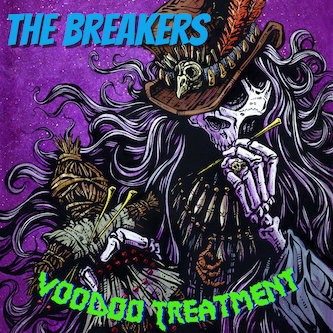 Windy City instrumental group The Breakers released a new CD in 2020 entitled Voodoo Treatment. An excellent follow-up to the band’s 2019 album, Transmissions From A Hornet-Free Environment, the 40-minute, 14-track Voodoo Treatment is another fine showcase for The Breakers, the Chicago-based band consisting of lead guitarist Jim Abrahams (guitars, effects, bass), Jayson Slater (bass) and Marc Lockett (drums). With one hard-hitting instrumental track after the next, Voodoo Treatment also benefits from additional musicians performing on a range of instruments, while production by Craig Williams keeps the studio sound raging in the right directions. A veritable sonic hurricane, The Breakers create instrumental rock with a nod to traditional surf, yet there’s also a more aggressive dimension to the sound that would appeal to psychedelic and garage-rock fans, even those old enough to remember the electrifying rock guitar sounds of the late 1960s. Hats off to Jim Abrahams for also curating and releasing another CD entitled Chicago Surf Rally. A charity album for the Illinois COVID-19 Response Fund, the 79-minute, 27-track compilation features selections from nine bands contributing a range of music. Jim’s band The Breakers are featured with three cuts here, along with more surf-rock sounds by instro bands such as Alewife, Spies Who Surf, The Cocktail Preachers, while all the bands featured on Chicago Surf Rally summon up their best 1960s-era Spy / Surf instro sounds. On Voodoo Treatment, guitarist / composer Jim Abrahams takes the Breakers sound to new heights. Hard to miss with that stunning CD cover art, Voodoo Treatment, and in fact all of the Breakers albums, will be of interest to surf-rock instrumental fans world-wide.
Windy City instrumental group The Breakers released a new CD in 2020 entitled Voodoo Treatment. An excellent follow-up to the band’s 2019 album, Transmissions From A Hornet-Free Environment, the 40-minute, 14-track Voodoo Treatment is another fine showcase for The Breakers, the Chicago-based band consisting of lead guitarist Jim Abrahams (guitars, effects, bass), Jayson Slater (bass) and Marc Lockett (drums). With one hard-hitting instrumental track after the next, Voodoo Treatment also benefits from additional musicians performing on a range of instruments, while production by Craig Williams keeps the studio sound raging in the right directions. A veritable sonic hurricane, The Breakers create instrumental rock with a nod to traditional surf, yet there’s also a more aggressive dimension to the sound that would appeal to psychedelic and garage-rock fans, even those old enough to remember the electrifying rock guitar sounds of the late 1960s. Hats off to Jim Abrahams for also curating and releasing another CD entitled Chicago Surf Rally. A charity album for the Illinois COVID-19 Response Fund, the 79-minute, 27-track compilation features selections from nine bands contributing a range of music. Jim’s band The Breakers are featured with three cuts here, along with more surf-rock sounds by instro bands such as Alewife, Spies Who Surf, The Cocktail Preachers, while all the bands featured on Chicago Surf Rally summon up their best 1960s-era Spy / Surf instro sounds. On Voodoo Treatment, guitarist / composer Jim Abrahams takes the Breakers sound to new heights. Hard to miss with that stunning CD cover art, Voodoo Treatment, and in fact all of the Breakers albums, will be of interest to surf-rock instrumental fans world-wide. 